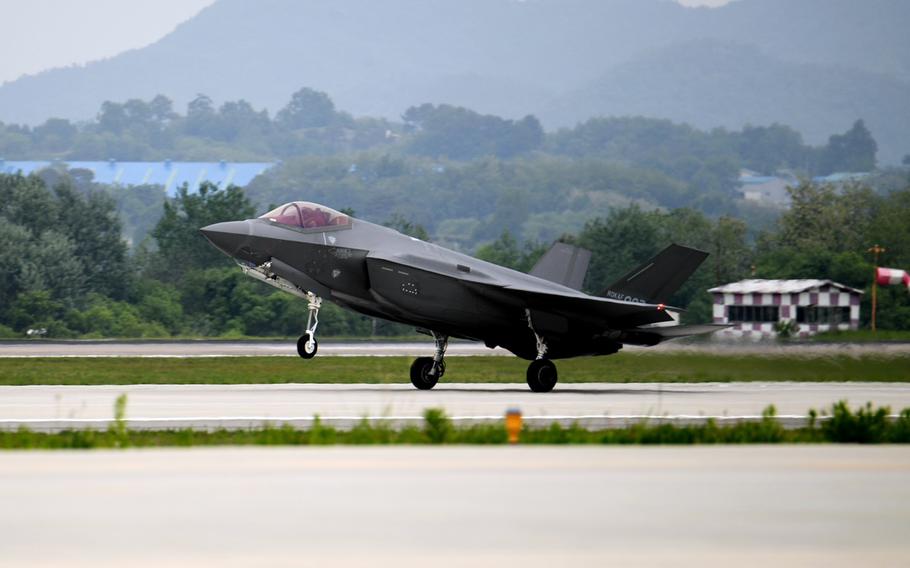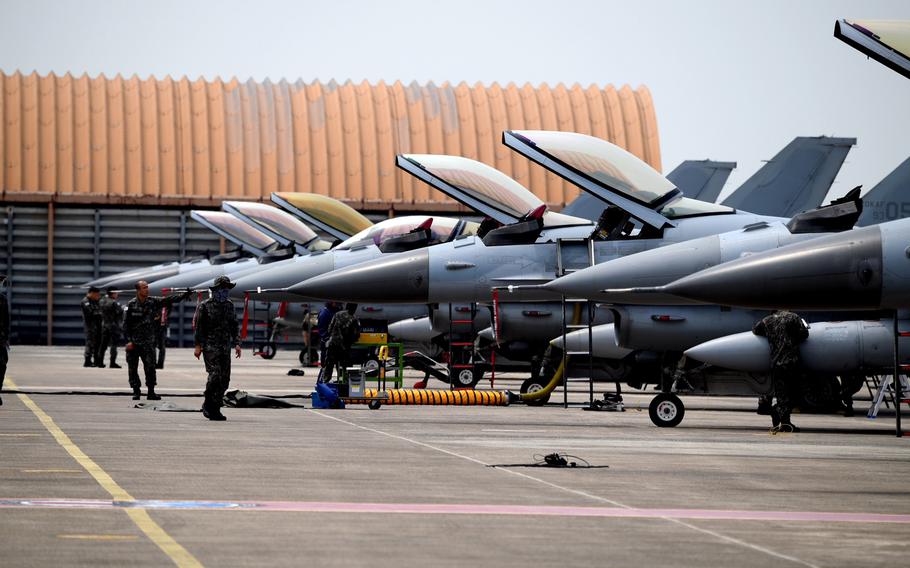
A South Korean air force F-35A Lightning II takes off from Cheongju Air Base during the weeklong Soaring Eagle exercise, May 12, 2023. (South Korea Ministry of National Defense)
CAMP HUMPHREYS, South Korea — Large-scale aerial drills are underway again over the Korean Peninsula, nearly a month after South Korea carried out similar training with the United States.
More than 60 South Korean aircraft are taking part in the weeklong, biannual Soaring Eagle exercise that kicked off Friday. It consists of aerial combat scenarios, ground-to-air missile simulations and aerial refueling training, according to a Ministry of National Defense news release.
Only South Korean aircraft are taking part in the exercise, according to the release. They include F-35A Lightning IIs, F-15K Slam Eagles, KF-16s, KA-1 close air support aircraft and KC-330 refuelers.

South Korean air force KF-16 multirole fighters stage at Cheongju Air Base during the weeklong Soaring Eagle exercise, May 12, 2023. (South Korea Ministry of National Defense)
Soaring Eagle’s purpose is to “respond swiftly to recent, repeated enemy provocations and threats and to have the best operational capability," air force Col. Won Kwonsoo, chief of the Air Combat Command’s Operational Training Division, said in the release.
The exercise comes 29 days after North Korea last fired a long-range ballistic missile that flew east for 620 miles on April 12. The missile prompted the Japanese government to warn Hokkaido residents to seek shelter before it splashed down in the Sea of Japan, or East Sea.
North Korea has fired 12 ballistic missiles in nine separate days of testing so far this year.
Soaring Eagle follows several large-scale exercises by the United States and South Korean militaries.
On March 20, roughly 1,200 U.S. and South Korean soldiers carried out four days of live-fire training with the M777 howitzer, Stryker armored fighting vehicles, AH-64E Apache attack helicopters and A-10 Thunderbolt II Warthog close air support aircraft. Those drills took place about 16 miles from the Demilitarized Zone separating North and South Korea.
One month later, U.S. sailors and Marines trained with their South Korean counterparts for the two-week Ssangyong Exercise that included more than 30 ships, 50 amphibious assault vessels and 70 aircraft.
The joint drills are part of Seoul and Washington’s efforts to expand the scope of their military alliance and to restore the “realistic, theater-level combined exercise system,” the White House said in an April 26 fact sheet.
During South Korean President Yoon Suk Yeol’s state visit to the White House on April 26, he and President Joe Biden released a joint statement saying their two countries will “broaden and deepen our ties as an alliance in action toward the future.”
North Korea’s state-run Korean Central News Agency criticized Yoon’s visit in reports and accused Seoul of trying to fuel tensions on the Korean Peninsula.
The U.S. and South Korea’s “hostile activities against [North Korea]” will end “tragically,” KCNA reported on May 5.
Stars and Stripes reporter Yoo Kyong Chang contributed to this report.